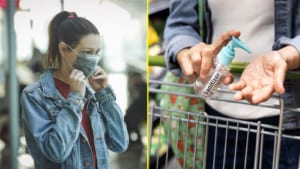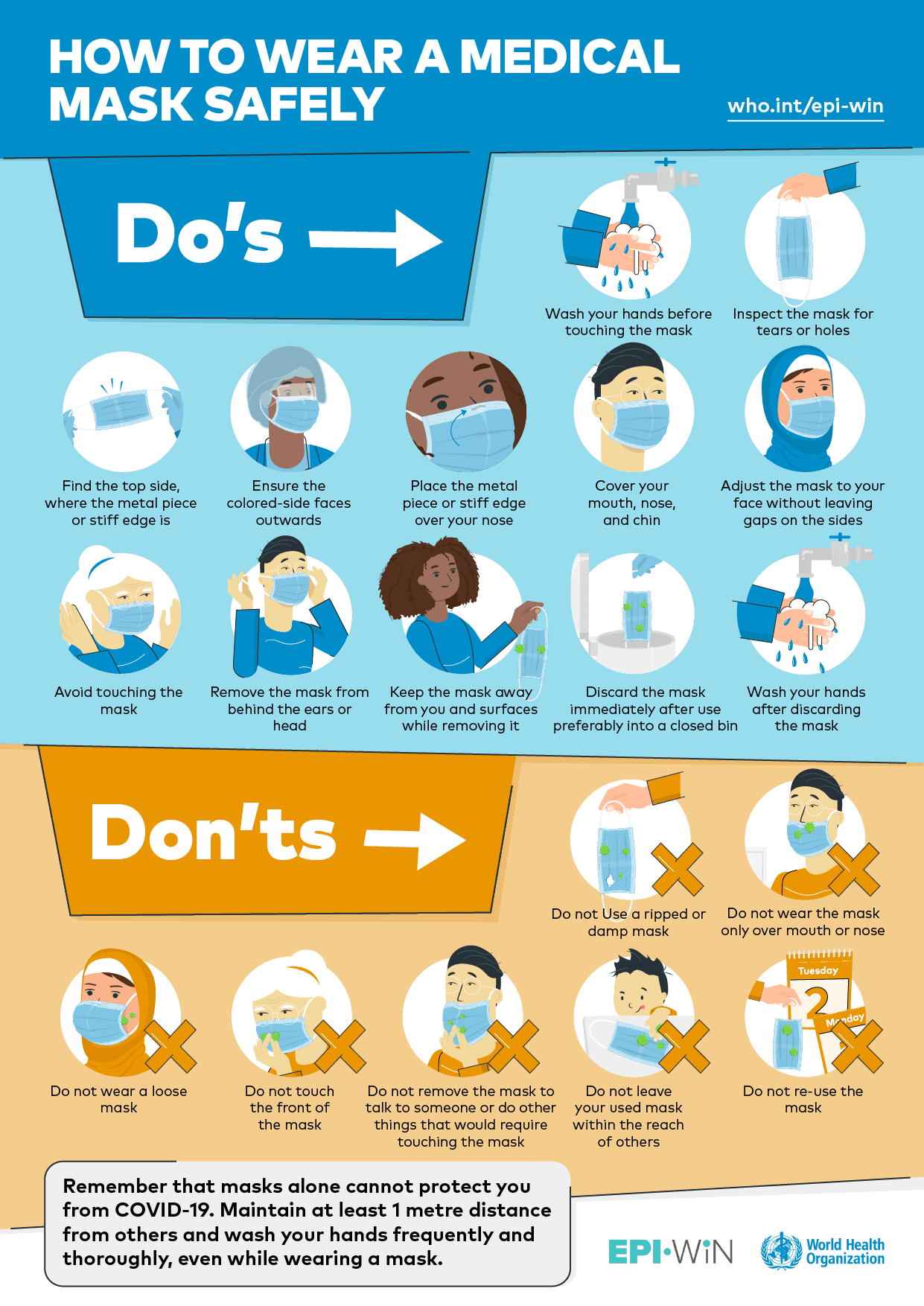The choice to wear a face mask could be a valuable tool in preventing the spread of germs and viruses.
A recent study shows that face coverings reduce up to a threefold the spread of viruses. Respiratory diseases are most commonly spread through coughing, sneezing, or talking when tiny droplets from the mouth or nose land on another person.
But even as they help in reducing the spread of viruses, coverings could lead to more reinfections if you do not adhere to proper safety guidelines.
What are face masks? Can they help?
Masks are coverings made from different materials with ties or elastic bands that help cover your nose and mouth, hence preventing the spread of viruses. Surgical masks are the most common and effective ones.
If you wear them correctly, masks help reduce the transmission of relatively large microorganisms splashes and droplets.
Surgical three-layered masks feature the following:
- Outer layer to repel body fluids such as blood
- Middle layer which filters pathogens
- Inner layer for the absorption of moisture in exhaled air
Some face masks may not be able to help against some particles, given the edges don’t fit tightly around the mouth and nose.

Who Should Wear Face Masks?
Anyone getting out in public, or where the risk of contracting respiratory-related viruses are high, should wear a face mask to avoid contracting or spreading the same.
However, the Centers for Disease Control recommends that people wear face masks during a viral outbreak, especially:
- Those who are suffering from specific respiratory illness
- Those showing signs and symptoms of the illness
- Those taking care of patients suffering from respiratory illnesses.
For health workers, however, WHO recommends that they use surgical masks and take strict safety measures since they are at higher risk. They include the N95 and FFP3, which help to offer protection against tiny particles and to filter out 95% particles.
The masks also have a tight-fitting to prevent possible leakage on the edges.
Surgical masks are also fluid-resistant and offer protection against larger airborne particles.
Home-made masks, on the other hand, helps to reduce significantly the chances of virus spread among those not showing symptoms of the illness.
Between 24 and 48 hours of infection are mainly the most critical as you won’t even know you are infected, hence spreading it unknowingly. Wearing face-covering reduces such.
Despite their crucial role, there is little scientific backing for the use of masks for members of the public. They can easily get contaminated when people sneeze or cough around the person wearing it.
Further, they could give a false sense of security to people wearing them, making them ignore other essential measures such as proper hand hygiene and the need for social distance, which are the most effective preventive measures.

When to Wear a Face Mask
According to the World Health Organization, only wear a mask when experiencing the symptoms of respiratory infections such as cough.
WHO also recommends that you wear a mask when offering care for a respiratory-illness patient, more specifically when you’re 6 feet close to the patient.
Surgical masks, for instance, effectively trap bigger respiratory illness droplets. However, the case could be different with some viruses such as the coronavirus because;
- They have tiny particles.
- There can be a possible leakage through the areas not adequately covered by the mask given it doesn’t fit tightly on the edges.
The Center for Disease Control also recommends that the public use masks when in public gatherings, even teaching people how to make them.
Bottom-line is, masks act as a spread barrier between the caregiver and the patient and not a shield. Hence, CDC does not declare them bullet-proof for viral safety since they’re not sealed and could allow in small particles.
Whether or not you’re sick, wearing a mask when in public or gathering is a simple show of care to the people around you.
Putting On a Mask – The Dos
While face masks can be useful in preventing the spread of larger virus particles, they also present many risks.
The outer part of the mask is more likely to be contaminated. When it so happens, touching it and touching your face without taking proper measures such as hand hygiene could lead to contamination. If you have to wear a mask, observe the following;
- First, wash your hands thoroughly with soap and running water for at least 20 seconds. Be sure to reach all the parts of the hand, including the nails, palm, and the back of the hand. Alternatively, you can rub your hands with alcohol-based hand sanitizer.
- Next, check the covering to see if you can spot such defects as tearing.
- If there’s no damage, wear the mask by placing the colored part outward. Carefully position the mask to cover your nose and mouth.
- If it has ear loops, carefully place them on each ear. For the ones with strings, use them to hold the mask, nicely tying the upper and lower strings at the back of your head. The ones with bands should be easier to manage. Roll the band to the back of your head.
- Further, ensure the upper strip of the mask takes the shape of your nose. To do this, pinch it as you press it down with your fingers.
- Ensure the bottom of the mouse covers both your mouse and chin. If not, pull it down to position it well until it fits.
- Ensure the mask fits, giving you a comfortable, well-protected, and cozy feeling.
- Resist the temptation of touching the mask once its in position. If you have to, be sure to properly clean your hands using alcohol-based sanitizer or soap and water.
- Dispose of face masks when you notice any signs of damage, when it gets dirty or when overly moist. If it’s reusable, wash and dry it properly as regularly as possible. Alternatively, you can keep the mask in a plastic bag until you’re able to clean it. On both occasions, thoroughly cleanse your hands after that.
- Dispose of the mask properly in a closed bin for extra safety. Wash your hands with hot water and soap for at least twenty seconds.
Surgical masks and home-made coverings don’t offer the same level of protection. However, if you use them properly as outlined above, you can save the community. Following these guidelines will significantly reduce the spread of viruses.
The Don’ts
Putting on a mask may not be precisely applicable to everyone. Children under 2 years shouldn’t wear masks.
Similarly, those having difficulties in breathing should also avoid such coverings as they tend to do more damage than good.
To avoid contamination, take the following measures when the mask is in position:
- Avoid touching the mask unnecessarily once you have it on. The outer parts of the mask trap pathogens when someone sneezes or coughs close to you. Some viruses can stay for days on the clothe. Touching it and touching your face could be disastrous.
- Don’t leave the mask hanging from one ear. This carelessness could lead to contamination.
- Don’t leave the mask hanging on your neck. If you no longer need it, safely remove and dispose of it appropriately.
- Tempting as it may seem, do not reuse a disposable mask. Reusing masks meant for single-use, such as surgical masks, puts you and others in grave danger.
- Do not crisscross ties. Ensure each tie is on the right ear. This will ensure the mask fits well, leaving no space for pathogens to enter.
- Don’t wear a mask that is worn out, damaged, or dump. Dispose of it immediately in a closed bin
- Remove the mask as soon as you are away from patients or public gatherings.
Cloth coverings or face masks?
Both cloth coverings and face masks can help prevent viruses in public gatherings or when in close contact with infected persons.
Though their level of protection is lower compared to respirators and surgical masks, cloth coverings still offer protection against respiratory droplets, which might contain pathogens. Here are tips on proper usage:
- When using them, choose one that fits perfectly for maximum protection.
- Avoid face coverings made of polyester, synthetic, or spandex. Most viruses can stay longer on these materials.
- Instead, go for ones made of 100% cotton. If you make the masks on your own, the Johns Hopkins Medicine’s sample design can come in handy.
- To avoid shrinking, wash, and dry the fabric two or three times before using it.
- Scarfs could work in some instances. However, they’re not very effective, especially for highly infectious pathogens.
 Final Thoughts on How to Wear a Face Mass to Stop Spreading Germs
Final Thoughts on How to Wear a Face Mass to Stop Spreading Germs
Though not as efficient as surgical masks and respirators, face masks protection against pathogens. While respirators protect against smaller particle pathogens, masks help with larger airborne particles.
However, you must adhere to the above safety measures to avoid putting yourself and those around you in danger. Learning how to correctly choose, make, wear, and dispose of your mask will help lower transmission rates.
For maximum protection, couple up wearing masks with other safety measures such as maintaining high levels of hygiene, keeping social distance, and seeking medication early. Be sure also to follow the right guidelines for making home-made masks.
The post Nurses Share How to Wear a Face Mask to Avoid Germs + What Not to Do appeared first on Power of Positivity: Positive Thinking & Attitude.
【Top 10 Malaysia & Singapore Most Beautiful Girls】Have you follow?
